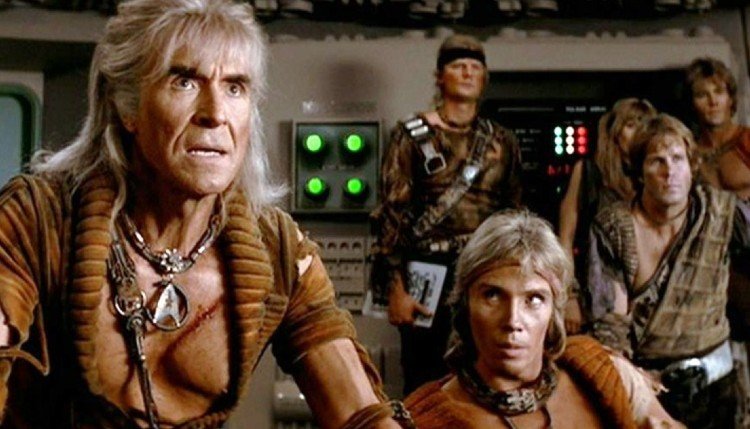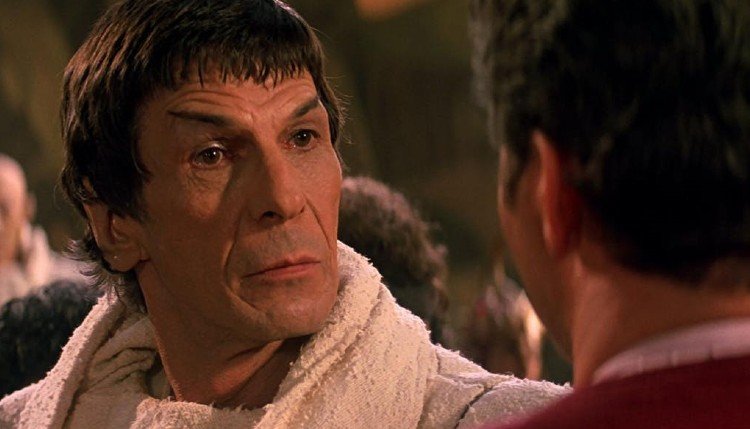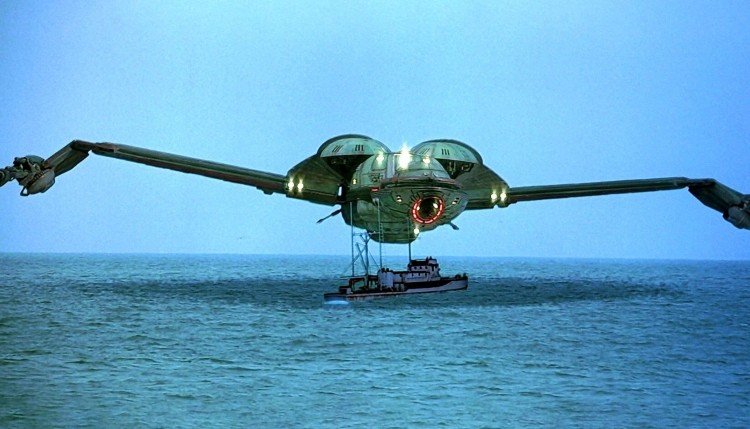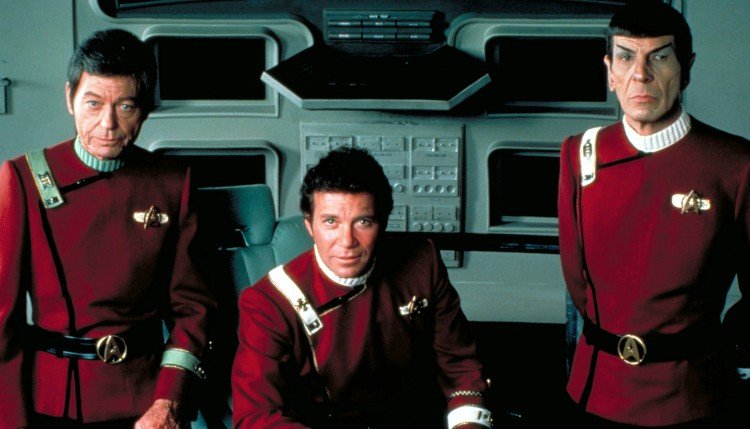Star Trek II: The Wrath of Khan (1982) Star Trek III: The Search for Spock (1984) Star Trek IV: The Voyage Home (1986)
Star Trek II: The Wrath of Khan, 1982 (William Shatner) Paramount Pictures
Star Trek III: The Search for Spock, 1984 (DeForest Kelley) Paramount Pictures
Star Trek IV: The Voyage Home, 1986 (Leonard Nimoy) Paramount Pictures
“You are my superior officer. You are also my friend. I have been and always shall be yours.”
Considered the best of the Star Trek movies, director Nicholas Meyer wisely applied the lessons learned from the first film to launch the popular television franchise and utilized television production techniques to craft this clever sequel to Star Trek: The Motion Picture. To say that Star Trek II is faithful to the NBC television series is obvious even down to the story, which sequelizes not only the film series, but also the first season episode, “Space Seed.” Star Trek II brings back Khan Noonian Singh (electrifying Ricardo Montalban), a product of 20th century genetic engineering, who we last saw being shipped into exile with his crew by Kirk at the end of the episode.
Unfortunately, a short time later, the disruption of a nearby planet causes Khan’s new paradise to become a desert filled with horrid, mutated creatures. Khan captures the U.S.S. Reliant (a science vessel on alert for appropriate planetary bodies upon which to experiment) by means of hideous slug-like creatures inserted into key personnel Chekov and Terrell’s ears to control their minds. Khan and his crew travel to space station Regula 1, where Doctors Carol (Bibi Besch) and her son, David Marcus (Merritt Buttrick) are developing the “Genesis” device, which can turn any lifeless astronomical body into a fertile garden.

Khan wants “Genesis” (for reasons that are never adequately explained – perhaps he feels he has it coming to him), but he has to get through Admiral James T. Kirk (William Shatner) to take it. Kirk, ostensibly on board the U.S.S. Enterprise to supervise a training assignment under Captain Spock (Leonard Nimoy), assumes command of the ship to rescue his former lover, Carol, and their son. This presents difficulties for Kirk, who is “celebrating” his birthday. For the first time in his life and career, he is confronted with his own mortality, which turns out to be a much greater foe than Khan, or an irate Gorn, or a community of sadistic telepaths.
With Spock and McCoy serving as advisers (and even more fascinating, Jungian extensions of his subconscious in the form of wisdom and logic), Kirk must fight an enemy who swore vengeance upon him fifteen years before, as well as form a temporary truce with his new family in the form of Carol and David. For his part, David is an angry genius who would like to flatten his father for what he perceives as abandonment. The “Genesis” device represents an analogy for our own atomic bomb; utilizing science that could’ve saved us, the bomb has the power to kill us all.
Nicholas Meyer’s next project would be The Day After for ABC. The beginning of a successful trilogy that ended with Star Trek IV: The Voyage Home in 1986, Star Trek II: The Wrath of Khan is a rare case of a cinema adaptation that succeeds and then eventually improves upon it’s source material (in this case, the television series) by embracing the finest aspects of the original material.

All of the narrative beats are there: the fundamental conflict between Spock and McCoy (DeForest Kelley), which would be turned on its ear for the sequel, Star Trek III: The Search for Spock, a great villain in Khan, a hysterically angry and passionate Kirk, excellent visual effects and battle scenes, and a complex moral/philosophical argument embodied in “Genesis.” This is what a Star Trek film should be.
“I … have HAD … enough of … YOU!”
Star Trek III: The Search for Spock came out at a time that baffled audiences and Star Trek fans. Leonard Nimoy had made positively no bones about the idea that he would never play the part of Spock again. In fact, his participation in Star Trek II was on the condition that the character die. It might’ve been that he was tired of being identified (solely in the pop culture) as Spock. He wrote a book in 1975 titled I Am Not Spock. He would write the follow-up, I Am Spock twenty years later.
It’s hard for an actor when his arguably best or most iconic work occurred at the beginning of his career. Indeed, he had been acting professionally for only fourteen years (in tiny bit parts) before getting the “Cage” script that would launch his involvement with Star Trek. He was an actor who reveled and rejoiced in spirituality and love, but here he was: relegated to a straight-faced, unemotional, cold characterization. There were times when you could see emotion in his piercing eyes without betraying that conceit in the performance.
One of my favorite performances was his concern for a brutalized Dr. McCoy in the third season episode, “The Empath.” Star Trek II: The Wrath of Khan revitalized his interest in Spock so much that he lobbied to direct the third movie, a continuation of the story after Spock’s death in the final scenes. Kirk’s son David (Merritt Buttrick) and Lieutenant Saavik are studying the Genesis planet in the Mutara sector when they come upon humanoid life signs, possibly those of Spock’s as he was buried on the planet’s surface.

Harve Bennett’s script is so brilliantly written, one can easily forget so many other elements that add up to the central idea. Kirk is not only broken after Spock’s death, his friend Dr. McCoy (DeForest Kelley) is manifesting strange personality traits. On Earth, he’s visited by Spock’s father, Sarek (Mark Lenard) who informs him Spock still lives in a kind of spiritual and mental limbo whereby he has imparted his soul (called a “katra”) into McCoy’s mind. Spock’s body and McCoy’s mind must be taken to Vulcan where a ritual can be performed to restore Spock and repair McCoy.
Unfortunately, Starfleet forbids Kirk from taking Enterprise (shortly to be decommissioned) to the Genesis planet. Kirk defies orders and steals the ship with Scotty, Sulu, and Uhura’s help. A psychotic Klingon commander named Kruge (Christopher Lloyd) destroys David and Saavik’s ship and orders David’s death. Kirk surrenders and destroys the Enterprise as a boarding party transports over. The Genesis planet is being ripped apart due to the instability of its matrix (a fact I never understood).
It’s staggering to observe that all of this destruction was shot on a soundstage. The movie was filmed entirely on the Paramount lot soundstages. Compared to Robert Wise and Nicholas Meyer, Nimoy is more an actor’s director, spending hours on set getting the best performances out of his actors. The always reliable Shatner turns in an incredible performance that goes far beyond anything he had done on the Original Series. Each character gets a moment to shine and, for once, the characters act as friends rather than members of a crew. This is an altogether different Star Trek movie.
“This is an extremely primitive and paranoid culture.”
There’s a slick sense of humor to Star Trek IV: The Voyage Home that had rarely been exploited in the franchise or the television series. There were many moments of humor in the series, but there were really only two straight-up, out-and-out comedy episodes: “The Trouble With Tribbles” and “A Piece of the Action.” The latter is the fish-out-of-water, when-in-Rome kind of humor we would see in the third Star Trek motion picture sequel, again directed by Leonard Nimoy, from a story by Nimoy and Harve Bennett, and written by Bennett, Nicholas Meyer, Steve Meerson, and Peter Krikes.

This is Harve Bennett once again pulling rabbits out of hats and making the impossible possible. This is a direct continuation of Star Trek III with Kirk and crew (and a newly resurrected Spock) on their way home in a stolen Klingon Bird of Prey, when an object of unknown origin (a probe) enters our Solar System, parks over Earth, and begins sucking up our planet’s natural resources. The object emits unusual noises. It drains energy from nearby ships and space stations, so Starfleet warns other ships to stay away. Kirk gets the message.
They quickly figure out the probe is trying to communicate with a particular species of whale that went extinct in the 21st century. Since there are no whales to tell this probe what to go to do with itself, the Earth is doomed. Kirk decides to use the same “slingshot effect,” accidentally utilized in the Original Series episode, “Tomorrow Is Yesterday” (written by D.C. Fontana whom, I hope, got some credit or acknowledgement for this), to go back in time to the latter half of the 20th century so they can find whales, bring them forward in time, and tell this probe what to … well, you get it.
It’s not what you’d expect from a Star Trek sequel, particularly something that comes out of nowhere after the events of the previous two movies with their moments of space opera and drama, death and rebirth. Kirk and Spock find their whales, named George and Gracie, at the Cetacean Institute in Sausalito with the help of marine biologist Dr. Gillian Taylor (Catherine Hicks). Scotty and Dr. McCoy have to find a transparent casing strong enough to hold the whales and the water. Uhura and Checkov have to collect nuclear energy from a naval vessel (the U.S.S. Enterprise) in order to re-energize the power crystals necessary for the warp drive. Sulu has to steal a helicopter in order to transport the transparent casing to the cloaked Klingon ship.

It’s nice how everybody has a separate but important task to complete. It reminds me of an episode of The A-Team, except we’re not making tanks out of cars with flamethrowers aimed at knife-throwing punks. There is an environmental theme and, even though there is a preachy message directed at the audience, the movie itself isn’t terribly preachy. Gillian decides her life is nothing without her whales, so she stows away on the Klingon ship, and they go back to the 23rd century where they dump the whales into the Pacific and tell the probe what to go do with itself. The probe, apparently satisfied, leaves.
This is kind of like Star Trek: The Motion Picture, except with humor and a story. Is no one even the slightest bit concerned that Dr. Taylor’s absence in the 20th century will somehow have an effect in the future?* Apparently not. Time travel stories came back into style around the time of The Terminator’s release in 1984, but I sense Star Trek IV was more influenced by the comedy of Back to the Future, particularly the fish-out-of-water theme I noted earlier. I saw this movie in its opening weekend with my friend, Jeremy and his family, and I was surprised by the amount of humor in the movie, which could’ve been attributed to the fact that Eddie Murphy was originally pursued to play the part of an astrophysicist who helps the crew. When he backed out to make The Golden Child (what?), the part was rewritten for Hicks.
*It’s possible Dr. Taylor’s disappearance caused a paradox in that because she was the foremost authority on humpback whales, the species went extinct without her protection. Think about it!

